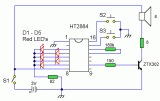Sound generator schematics
 This simple circuit generates narrow pulses at about 700-800Hz frequency. The pulses, containing harmonics up to the MHz region, can be injected into audio or radio-frequency stages of amplifiers, receivers and the like for testing purposes. A high-pitched tone can be heard from the speaker of the device under test when all is working properly. The clip must be connected to the ground of the device under test, touching with the probe the different stages of the circuit, starting from the last stage and going up towards the first. When the tone is no longer heard, the defective stage has been found....
[read more]
This simple circuit generates narrow pulses at about 700-800Hz frequency. The pulses, containing harmonics up to the MHz region, can be injected into audio or radio-frequency stages of amplifiers, receivers and the like for testing purposes. A high-pitched tone can be heard from the speaker of the device under test when all is working properly. The clip must be connected to the ground of the device under test, touching with the probe the different stages of the circuit, starting from the last stage and going up towards the first. When the tone is no longer heard, the defective stage has been found....
[read more]
 Here is the simplest melody generator circuit you can make using an IC.The UM66 series are CMOS IC’s designed for using in calling bell, phone and toys. It has a built in ROM programmed for playing music. The device has very low power consumption.Thanks for the CMOS technology.The melody will be available at pin3 of UM66 and here it is amplified by using Q1 to drive the speaker.Resistor R1 limits the base current of Q1 within the safe values.Capacitor C1 is meant for noise suppression....
[read more]
Here is the simplest melody generator circuit you can make using an IC.The UM66 series are CMOS IC’s designed for using in calling bell, phone and toys. It has a built in ROM programmed for playing music. The device has very low power consumption.Thanks for the CMOS technology.The melody will be available at pin3 of UM66 and here it is amplified by using Q1 to drive the speaker.Resistor R1 limits the base current of Q1 within the safe values.Capacitor C1 is meant for noise suppression....
[read more]
 Do you long for a beach holiday on a tropical island, but you don’t have the necessary wherewithal? We’ve got just the answer: build the i-TRIXX surf simulator, put on your headphones, and dream yourself away from this dreary realm. Let the rhythmic rush of the waves transport you to a sun-drenched beach with gently swaying palm trees, and relax for a while before returning to a chilly confrontation with reality. That’s the ultimate in low-budget travel....
[read more]
Do you long for a beach holiday on a tropical island, but you don’t have the necessary wherewithal? We’ve got just the answer: build the i-TRIXX surf simulator, put on your headphones, and dream yourself away from this dreary realm. Let the rhythmic rush of the waves transport you to a sun-drenched beach with gently swaying palm trees, and relax for a while before returning to a chilly confrontation with reality. That’s the ultimate in low-budget travel....
[read more]
 UM66 is a pleasing music generator IC which works on a supply voltage of 3V. the required 3V supply is given through a zener regulator. its out put is taken from the pin no1 and is given to a push pull amplifier to drive the low impedance loud speaker. A class A amplifier before push pull amplifier can be used to decrees the noise and improve out put. UM66 is a 3 pin IC package just looks like a BC 547 transistor....
[read more]
UM66 is a pleasing music generator IC which works on a supply voltage of 3V. the required 3V supply is given through a zener regulator. its out put is taken from the pin no1 and is given to a push pull amplifier to drive the low impedance loud speaker. A class A amplifier before push pull amplifier can be used to decrees the noise and improve out put. UM66 is a 3 pin IC package just looks like a BC 547 transistor....
[read more]
 This multi-tone siren is useful for burglar alarms, reverse horns, etc. It produces five different audio tones and is much more ear-catching than a single-tone siren. The circuit is built around popular CMOS oscillator-cum-divider IC 4060 and small audio amplifier LM386. IC 4060 is used as the mult-itone generator. A 100µH inductor is used at the input of IC 4060. So it oscillates within the range of about 5MHz RF. IC 4060 itself divides RF signals into AF and ultrasonic ranges. Audio signals of different frequencies are available at pins 1, 2, 3, 13 and 15 of IC 4060 (IC1)....
[read more]
This multi-tone siren is useful for burglar alarms, reverse horns, etc. It produces five different audio tones and is much more ear-catching than a single-tone siren. The circuit is built around popular CMOS oscillator-cum-divider IC 4060 and small audio amplifier LM386. IC 4060 is used as the mult-itone generator. A 100µH inductor is used at the input of IC 4060. So it oscillates within the range of about 5MHz RF. IC 4060 itself divides RF signals into AF and ultrasonic ranges. Audio signals of different frequencies are available at pins 1, 2, 3, 13 and 15 of IC 4060 (IC1)....
[read more]
 In Greek mythology, a siren was a demonic being (half bird, half woman). Later on this idea was transformed in art into a mermaid: a combination of a fish and a woman. Mechanical and electromechanical versions were invented even later, and electronic models were developed in the last century. Sirens are characterized by their ability to produce sounds that attract attention. With the exception of the flesh-and-blood models, they are thus used to warn people in a particular area of impending danger. The electronic versions are the most suitable for DIY construction....
[read more]
In Greek mythology, a siren was a demonic being (half bird, half woman). Later on this idea was transformed in art into a mermaid: a combination of a fish and a woman. Mechanical and electromechanical versions were invented even later, and electronic models were developed in the last century. Sirens are characterized by their ability to produce sounds that attract attention. With the exception of the flesh-and-blood models, they are thus used to warn people in a particular area of impending danger. The electronic versions are the most suitable for DIY construction....
[read more]
 This circuit generates a two-tone effect very much alike the cuckoo song. It can be used for door-bells or other purposes thanks to a built-in audio amplifier and loudspeaker. Used as a sound effect generator it can be connected to external amplifiers, tape recorders etc. In this case, the built-in audio amplifier and loudspeaker may be omitted and the output taken across C8 and ground. There are two options: free running, when SW1 is left open, and one-shot, when SW1 is closed. In this case a two-tone cuckoo song will be generated at each P1 pressing....
[read more]
This circuit generates a two-tone effect very much alike the cuckoo song. It can be used for door-bells or other purposes thanks to a built-in audio amplifier and loudspeaker. Used as a sound effect generator it can be connected to external amplifiers, tape recorders etc. In this case, the built-in audio amplifier and loudspeaker may be omitted and the output taken across C8 and ground. There are two options: free running, when SW1 is left open, and one-shot, when SW1 is closed. In this case a two-tone cuckoo song will be generated at each P1 pressing....
[read more]
 This circuit generates a dual-tone bells ringing similar to most door-bell units. It can be used in many applications other than door-bell. In the Notes below several options will be given in order to suit different needs. The circuit as shown in the diagram generates a "Ding-tone" when P1 is pressed and a "Dong-tone" when P1 is released. IC1D is the first-tone frequency generator and IC1F generates the second-tone....
[read more]
This circuit generates a dual-tone bells ringing similar to most door-bell units. It can be used in many applications other than door-bell. In the Notes below several options will be given in order to suit different needs. The circuit as shown in the diagram generates a "Ding-tone" when P1 is pressed and a "Dong-tone" when P1 is released. IC1D is the first-tone frequency generator and IC1F generates the second-tone....
[read more]
 This circuit generates an astonishingly real imitation of the chirping of the cricket. A suitable audio wave form is generated by IC2 and related components, driving the loudspeaker through Q1. To allow a more real-life behavior, the chirp is interrupted in a pseudo-casual way by two timers built around IC1C and IC1D, whose outputs are mixed into IC1B and further time-delayed by IC1A, driving the reset pin of IC2....
[read more]
This circuit generates an astonishingly real imitation of the chirping of the cricket. A suitable audio wave form is generated by IC2 and related components, driving the loudspeaker through Q1. To allow a more real-life behavior, the chirp is interrupted in a pseudo-casual way by two timers built around IC1C and IC1D, whose outputs are mixed into IC1B and further time-delayed by IC1A, driving the reset pin of IC2....
[read more]
 This circuit is intended for children fun, and can be installed on bicycles, battery powered cars and motorcycles, but also on models and various games and toys. With SW1 positioned as shown in the circuit diagram, the typical dual-tone sound of Police or Fire-brigade cars is generated, by the oscillation of IC1A and IC1B gates. With SW1 set to the other position, the old siren sound increasing in frequency and then slowly decreasing is reproduced, by pushing on P1 that starts oscillation in IC1C and IC1D....
[read more]
This circuit is intended for children fun, and can be installed on bicycles, battery powered cars and motorcycles, but also on models and various games and toys. With SW1 positioned as shown in the circuit diagram, the typical dual-tone sound of Police or Fire-brigade cars is generated, by the oscillation of IC1A and IC1B gates. With SW1 set to the other position, the old siren sound increasing in frequency and then slowly decreasing is reproduced, by pushing on P1 that starts oscillation in IC1C and IC1D....
[read more]
 Feeling chirpy? Attract new friends with this modified hartley oscillator. You could also use it as a replacement doorbell....
[read more]
Feeling chirpy? Attract new friends with this modified hartley oscillator. You could also use it as a replacement doorbell....
[read more]
 This circuit uses the Holtek HT2884 IC to produce 8 different sound effects....
[read more]
This circuit uses the Holtek HT2884 IC to produce 8 different sound effects....
[read more]
 This circuit uses a UM3561 IC to produce four different sound effects...
[read more]
This circuit uses a UM3561 IC to produce four different sound effects...
[read more]
 Producing low-distortion sine waves, this oscillator operates over the range 16 to 22000 Hz....
[read more]
Producing low-distortion sine waves, this oscillator operates over the range 16 to 22000 Hz....
[read more]
 This circuit generates a two-tone effect very much alike the cuckoo sound. It can be used for door-bells or other purposes thanks to a built-in audio amplifier and loudspeaker....
[read more]
This circuit generates a two-tone effect very much alike the cuckoo sound. It can be used for door-bells or other purposes thanks to a built-in audio amplifier and loudspeaker....
[read more]
 This circuit is intended for children fun, and is suitable to be installed on bicycles, battery powered cars and motorcycles, but also in models and other games....
[read more]
This circuit is intended for children fun, and is suitable to be installed on bicycles, battery powered cars and motorcycles, but also in models and other games....
[read more]
 An electronic siren made from discrete components....
[read more]
An electronic siren made from discrete components....
[read more]
 This is a basic 555 squarewave oscillator used to produce a 1 Khz tone from an 8 ohm speaker. In the circuit on the left, the speaker is isolated from the oscillator by the NPN medium power transistor which also provides more current than can be obtained directly from the 555 (limit = 200 mA). A small capacitor is used at the transistor base to slow the switching times which reduces the inductive voltage produced by the speaker....
[read more]
This is a basic 555 squarewave oscillator used to produce a 1 Khz tone from an 8 ohm speaker. In the circuit on the left, the speaker is isolated from the oscillator by the NPN medium power transistor which also provides more current than can be obtained directly from the 555 (limit = 200 mA). A small capacitor is used at the transistor base to slow the switching times which reduces the inductive voltage produced by the speaker....
[read more]